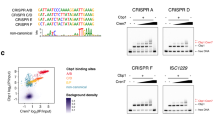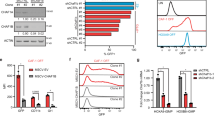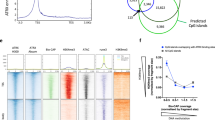Abstract
In vivo, a wild-type pattern of major histocompatibility complex (MHC) class II expression requires a locus control region (LCR). Whereas the role of promoter-proximal MHC class II regulatory sequences is well established, the function of the distal LCR remained obscure. We show here that this LCR is bound by the MHC class II-specific transactivators regulatory factor X (RFX) and class II transactivator (CIITA). Binding of these factors induces long-range histone acetylation, RNA polymerase II recruitment and the synthesis of extragenic transcripts within the LCR. The finding that RFX and CIITA regulate the function of the MHC class II LCR reveals an unexpected degree of complexity in the mechanisms controlling MHC class II gene expression.
This is a preview of subscription content, access via your institution
Access options
Subscribe to this journal
Receive 12 print issues and online access
$209.00 per year
only $17.42 per issue
Buy this article
- Purchase on Springer Link
- Instant access to full article PDF
Prices may be subject to local taxes which are calculated during checkout







Similar content being viewed by others
References
Cresswell, P. Assembly, transport, and function of MHC class II molecules. Annu. Rev. Immunol. 12, 259–293 (1994).
Viret, C. & Janeway, C.A.J. MHC and T cell development. Rev. Immunogenet. 1, 91–104 (1999).
Benoist, C. & Mathis, D. Regulation of major histocompatibility complex class II genes: X, Y and other letters of the alphabet. Annu. Rev. Immunol. 8, 681–715 (1990).
Mach, B., Steimle, V., Martinez-Soria, E. & Reith, W. Regulation of MHC class II genes: Lessons from a disease. Annu. Rev. Immunol. 14, 301–331 (1996).
Reith, W. & Mach, B. The bare lymphocyte syndrome and the regulation of MHC expression. Annu. Rev. Immunol. 19, 331–373 (2001).
Ting, J.P. & Trowsdale, J. Genetic control of MHC class II expression. Cell 109 (Suppl.), S21–S33 (2002).
Steimle, V., Otten, L.A., Zufferey, M. & Mach, B. Complementation cloning of an MHC class II transactivator mutated in hereditary MHC class II deficiency. Cell 75, 135–146 (1993).
Steimle, V. et al. A novel DNA binding regulatory factor is mutated in primary MHC class II deficiency (bare lymphocyte syndrome). Genes Dev. 9, 1021–1032 (1995).
Durand, B. et al. RFXAP, a novel subunit of the RFX DNA binding complex is mutated in MHC class II deficiency. EMBO J. 16, 1045–1055 (1997).
Masternak, K. et al. A gene encoding a novel RFX-associated transactivator is mutated in the majority of MHC class II deficiency patients. Nat. Genet. 20, 273–277 (1998).
Nagarajan, U.M. et al. RFX-B is the gene responsible for the most common cause of the bare lymphocyte syndrome, an MHC class II immunodeficiency. Immunity 10, 153–162 (1999).
Masternak, K. et al. CIITA is a transcriptional coactivator that is recruited to MHC class II promoters by multiple synergistic interactions with an enhanceosome complex. Genes Dev. 14, 1156–1166 (2000).
Masternak, K. & Reith, W. Promoter-specific functions of CIITA and the MHC class II enhanceosome in transcriptional activation. EMBO J. 21, 1379–1388 (2002).
Brown, J.A., He, X.F., Westerheide, S.D. & Boss, J.M. Characterization of the expressed CIITA allele in the class II MHC transcriptional mutant RJ2.2.5. Immunogenetics 43, 88–91 (1995).
Dorn, A. et al. B cell control region at the 5′ end of a major histocompatibility complex class II gene: sequences and factors. Mol. Cell. Biol. 8, 3975–3987 (1988).
Carson, S. & Wiles, M.V. Far upstream regions of class II MHC Eα are necessary for position-independent, copy-dependent expression of Eα transgene. Nucleic Acids Res. 21, 2065–2072 (1993).
Li, Q., Harju, S. & Peterson, K.R. Locus control regions: coming of age at a decade plus. Trends Genet. 15, 403–408 (1999).
Carson, S. DNase I hypersensitive sites flank the mouse class II major histocompatibility complex during B cell development. Nucleic Acids Res. 19, 5007–5014 (1991).
Feriotto, G. et al. Sequencing of an upstream region of the human HLA-DRA gene containing X' and Y' boxes. Nucleic Acids Res. 23, 1671–1678 (1995).
Mischiati, C. et al. Analysis of the human HLA-DRA gene upstream region: evidence for a stem-loop array directed by nuclear factors. Biochimie 81, 219–228 (1999).
Ashe, H.L., Monks, J., Wijgerde, M., Fraser, P. & Proudfoot, N.J. Intergenic transcription and transinduction of the human β-globin locus. Genes Dev. 11, 2494–2509 (1997).
Gribnau, J., Diderich, K., Pruzina, S., Calzolari, R. & Fraser, P. Intergenic transcription and developmental remodeling of chromatin subdomains in the human β-globin locus. Mol. Cell 5, 377–386 (2000).
Plant, K.E., Routledge, S.J. & Proudfoot, N.J. Intergenic transcription in the human β-globin gene cluster. Mol. Cell. Biol. 21, 6507–6514 (2001).
Koch, W., Benoist, C. & Mathis, D. Anatomy of a new B-cell-specific enhancer. Mol. Cell. Biol. 9, 303–311 (1989).
Forsberg, E.C. & Bresnick, E.H. Histone acetylation beyond promoters: long-range acetylation patterns in the chromatin world. Bioessays 23, 820–830 (2001).
Elefant, F., Su, Y., Liebhaber, S.A. & Cooke, N.E. Patterns of histone acetylation suggest dual pathways for gene activation by a bifunctional locus control region. EMBO J. 19, 6814–6822 (2000).
Litt, M.D., Simpson, M., Recillas-Targa, F., Prioleau, M.N. & Felsenfeld, G. Transitions in histone acetylation reveal boundaries of three separately regulated neighboring loci. EMBO J. 20, 2224–2235 (2001).
Beresford, G.W. & Boss, J.M. CIITA coordinates multiple histone acetylation modifications at the HLA-DRA promoter. Nat. Immunol. 2, 652–657 (2001).
Wuarin, J. & Schibler, U. Physical isolation of nascent RNA chains transcribed by RNA polymerase II: evidence for cotranscriptional splicing. Mol. Cell. Biol. 14, 7219–7225 (1994).
Chowdhury, D. & Sen, R. Stepwise activation of the immunoglobulin μ heavy chain gene locus. EMBO J. 20, 6394–6403 (2001).
Leach, K.M. et al. Reconstitution of human β-globin locus control region hypersensitive sites in the absence of chromatin assembly. Mol. Cell. Biol. 21, 2629–2640 (2001).
Johnson, K.D., Christensen, H.M., Zhao, B. & Bresnick, E.H. Distinct mechanisms control RNA polymerase II recruitment to a tissue-specific locus control region and a downstream promoter. Mol. Cell 8, 465–471 (2001).
Bulger, M. & Groudine, M. Looping versus linking: toward a model for long-distance gene activation. Genes Dev. 13, 2465–2477 (1999).
Blackwood, E.M. & Kadonaga, J.T. Going the distance: a current view of enhancer action. Science 281, 61–63 (1998).
Engel, J.D. & Tanimoto, K. Looping, linking, and chromatin activity: new insights into β-globin locus regulation. Cell 100, 499–502 (2000).
Schubeler, D., Groudine, M. & Bender, M.A. The murine β-globin locus control region regulates the rate of transcription but not the hyperacetylation of histones at the active genes. Proc. Natl. Acad. Sci. USA 98, 11432–11437 (2001).
Travers, A. Chromatin modification by DNA tracking. Proc. Natl. Acad. Sci. USA 96, 13634–13637 (1999).
Orphanides, G. & Reinberg, D. RNA polymerase II elongation through chromatin. Nature 407, 471–475 (2000).
Wittschieben, B.O. et al. A novel histone acetyltransferase is an integral subunit of elongating RNA polymerase II holoenzyme. Mol. Cell 4, 123–128 (1999).
Linhoff, M.W., Harton, J.A., Cressman, D.E., Martin, B.K. & Ting, J.P. Two distinct domains within CIITA mediate self-association: involvement of the GTP-binding and leucine-rich repeat domains. Mol. Cell. Biol. 21, 3001–3011 (2001).
Sisk, T.J., Roys, S. & Chang, C.H. Self-association of CIITA and its transactivation potential. Mol. Cell. Biol. 21, 4919–4928 (2001).
Accolla, R.S. Human B cell variants immunoselected against a single Ia antigen subset have lost expression in several Ia antigen subsets. J. Exp. Med. 157, 1053–1058 (1983).
Hume, C.R., Shookster, L.A., Collins, N., O'Reilly, R. & Lee, J.S. Bare lymphocyte syndrome: altered HLA class II expression in B cell lines derived from two patients. Hum. Immunol. 25, 1–11 (1989).
Tsang, S.Y., Nakanishi, M. & Peterlin, B.M. Mutational analysis of the DRA promoter: cis-acting sequences and trans-acting factors. Mol. Cell. Biol. 10, 711–719 (1990).
Bontron, S., Ucla, C., Mach, B. & Steimle, V. Efficient repression of endogenous major histocompatibility complex class II expression through dominant negative CIITA mutants isolated by a functional selection strategy. Mol. Cell. Biol. 17, 4249–4258 (1997).
Acknowledgements
We thank A. Muhlethaler-Mottet for providing the pDRAprox plasmid; N. Hernandez and J. Svejstrup for providing antibodies; M. Zufferey and S. Landmann for help with cell culture and real-time PCR; and M. Strubin for valuable discussions. This work was supported by grants from the Swiss National Science Foundation and NovImmune SA.
Author information
Authors and Affiliations
Corresponding author
Ethics declarations
Competing interests
The authors declare no competing financial interests.
Rights and permissions
About this article
Cite this article
Masternak, K., Peyraud, N., Krawczyk, M. et al. Chromatin remodeling and extragenic transcription at the MHC class II locus control region. Nat Immunol 4, 132–137 (2003). https://doi.org/10.1038/ni883
Received:
Accepted:
Published:
Issue Date:
DOI: https://doi.org/10.1038/ni883
This article is cited by
-
The transcription factor Rfx7 limits metabolism of NK cells and promotes their maintenance and immunity
Nature Immunology (2018)
-
The class I/IV HDAC inhibitor mocetinostat increases tumor antigen presentation, decreases immune suppressive cell types and augments checkpoint inhibitor therapy
Cancer Immunology, Immunotherapy (2018)
-
RFX transcription factors are essential for hearing in mice
Nature Communications (2015)
-
Cx36 Is a Target of Beta2/NeuroD1, Which Associates with Prenatal Differentiation of Insulin-producing β Cells
The Journal of Membrane Biology (2012)
-
DNA methylation dysregulates and silences the HLA-DQ locus by altering chromatin architecture
Genes & Immunity (2011)



